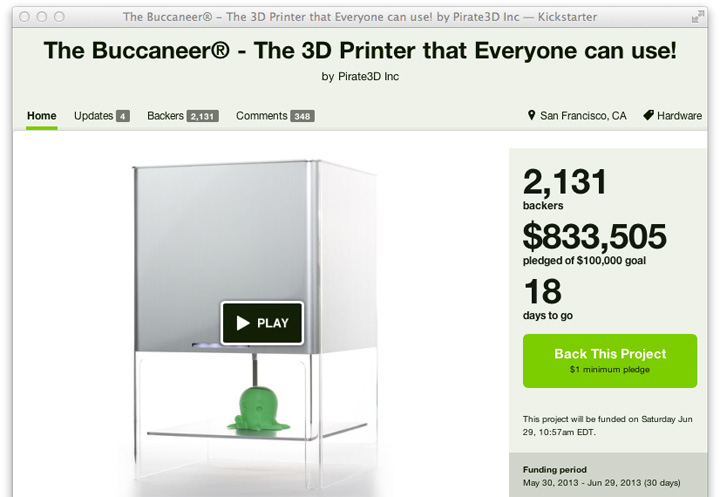
Whether it’s holding down a gym in Pokemon Go, earning free rides on Uber, or helping clients gain thousands of Facebook likes, life’s a computer game for Titan Lee.
For the record, his parents didn’t give him that name. Titan is a gaming handle he’s used since his youth, and it’s stuck ever since. He doesn’t mind because the name is memorable and good for branding purposes, he tells me.
A digital marketer running his own consultancy, Titan uses a mix of conventional and unconventional methods to achieve whatever the goal is: getting press coverage, growing social media reach or – as he tends to do lately – acting as a crowdfunding whisperer.
He successfully ran two crowdfunding campaigns, most notably that of 3D-printing startup Pirate3D, which still holds the record for Singapore’s most successful crowdfunding campaign with US$1.43 million raised.
He also managed Singapore startup TinyMOS’ campaign for a tiny astronomy camera. It raised almost US$400,000, over three times its original goal.
Titan calls himself a greyhat growth hacker, which means he sometimes employs methods that other marketers wouldn’t touch with a ten-foot pole.
“My exposure to the dark side of digital marketing was from very young,” he says. “I realize that the strategies and the mindset that they use can be used for good. So you don’t have to go illegal or be unethical. You can be along the grey line and still produce results.”
Mailing list hacks
It’s this mindset that led to Pirate3D’s record-breaking outing on Kickstarter. That and meticulous preparation which began months before the launch of the campaign. A sizable US$37,000 budget to run it helped.
Titan refined the sales pitch for the product – “the world’s cheapest 3D printer.” He studied past successes on Kickstarter via Kicktraq, and saw a trend: the best campaigns see a huge spike in pledges in the first five days, which then tapers off.

The most important objective for any campaign, therefore, is to create momentum at the beginning, which gives you a higher chance of getting highlighted by Kickstarter or Indiegogo. When Kickstarter puts you on its home page, it leads to more visibility and more pledges.
Getting momentum is all about the pre-campaign mailing list. To build it, Titan employed 20 virtual assistants from Pakistan, India, and the Philippines. They scraped email addresses off colleges in every US state, targeting employees in relevant faculties like architecture, engineering, and design.
He considered adding email addresses from the backers of Pebble, a smartwatch that had a hit campaign on Kickstarter, and planned to contact the pledgers as part of a mid-campaign blast.
But he didn’t because the Pirate3D crowdfunding had initial success and he didn’t want to jeopardize it. Kickstarter’s terms and conditions do not allow spamming backers from other campaigns.

Titan then ran a prize-guessing contest for the 3D printer. He used Rafflecopter, which built viral mechanisms into the contest.
If people share about the raffle or enter their friends’ email addresses, they get additional chances to win.
“We created a loop at every single touchpoint to get them to refer more,” he says.
Even the “thank you” page which appears after users sign up for the mailing list has buttons asking them to share on Facebook and Twitter. The press releases he sent out beckoned people to sign up.
Media publicity hacks
Titan engaged journalists and bloggers early, befriending them before seeking coverage. He then sought a hook that would entice writers, and Pirate3D’s low pricing was it.
The next step was simply to succeed. Pirate3D raised US$100,000 in 10 minutes, creating a torrent of press coverage. Every time the campaign hit a milestone, such as achieving the initial goal, there was another wave of coverage, which spiralled into more pledges.
Titan used an interesting trick to get Pirate3D’s Kickstarter page ranked in the top five search results on Google for “3D printer.”
He included the URL “pirate3d.com/kickstarter” in the pre-campaign press releases he sent out. They were then automatically propagated to over 200 sites via PRWeb, creating thousands of links.
Once Pirate3D’s Kickstarter page went up, Titan redirected the URL to the it, using a 301 redirect. Instantly, Google propelled Pirate3D to the coveted page one.
Titan also used traditional banner advertising, mainly through BuySellAds. One thing he regretted was using video advertising.
“That’s the worst thing to do. Don’t ever do that,” he says. “Nobody wants to watch a video before watching another video.”
He made the mistake of not designing a video specially to grab the attention of disinterested viewers. Titan used the campaign video as the ad, but the content was made for people who were already interested in 3D printing. In the end, Titan didn’t get good results from video ads.
Yet he emphasized that an important part of gaining momentum is to have a good campaign video, which will become your most shared media. “If you have a tight budget, spend it on the video,” he says.
The most important element of a good crowdfunding video? Explaining your product in the first 30 seconds.
Here are some examples of bad crowdfunding videos, according to Titan:
His next assignment at TinyMOS proved tougher. He had a budget one-fifth the size, and a much shorter timeline. The product was different: while a 3D printer was a shiny, novel object that captivated geeks, TinyMOS’ astronomy camera is an improvement on an age-old product.
The market was more challenging too: it wasn’t a “high-converting niche” in which he could throw one or two dollars and get ten in return.
Nonetheless, Titan found a mix of old and new tricks to make it work. Once again, he sent out mass emails to a contact list, this time consisting of astronomy club leaders.
But unlike the Pirate3D campaign, which used isolated email blasts, he arranged automated follow-ups using Quickmail, and they were written in a personal and friendly way, as if a real human was hitting “send” on those messages.
A typical follow-up, received at say 2pm, would read something like this: “Hey, I hope you had a good lunch. I sent you an email earlier this morning but I forgot to send you this link.”

Photo credit: TinyMOS.
This approach resulted in more replies, although it was hard to track conversion because the club owners would forward the newsletter to members, after which the digital trail becomes lost.
Another tactic he employed with both projects was to infiltrate relevant Google Groups pretending to be a real user. He’d engage people in the forums and subtly mention the products he wanted to push.
Bot army
As someone who hung out at online blackhat forums in his younger days, Titan is well-versed in the “dark arts.” That includes using bots to artificially boost a social media account’s followers or a site’s traffic, which he says is frowned upon but not illegal.
On crowdfunding site Indiegogo, bots can manipulate the Gogofactor, which is the algorithm the site uses to decide which campaign to feature. The Gogofactor measures the popularity of a campaign using signals like Facebook likes and shares, which can be purchased cheaply.
News site Mashable too automates the way it gauges the popularity of content by calculating their traction on social media. The most shared content makes it to the front page. Again, this is easy to game with bots, he claims.
Titan became obsessed with the digital world through Neopets, a once-popular game that shared some similarities to Pokemon. He learned HTML by customizing his Neopets page, and later started a business creating websites.
He then tinkered with ways to make money off websites, and Google Adsense came into the picture.
The equation seemed simple: more traffic equals more money. Making it happen was hard. And so began a lifelong obsession of garnering the skills, strategies, and tactics needed to to plant his money tree.
“I wasn’t too good a student. I was very distracted in school as I was trying to start my own business,” he says.
Titan Lee will be speaking about crowdfunding at Techventure X Slush Singapore, which is an anchor event under the Singapore Week of Innovation & TeCHnology (SWITCH). SWITCH is a platform where complementing tech and innovation events come together to “plug and play” in an open place-making concept.
If you are interested to attend Slush, you can purchase your tickets here using this promotion code for a 25% discount.
This post The Titan behind Singapore’s most successful crowdfunding campaigns appeared first on Tech in Asia.
from Tech in Asia https://www.techinasia.com/titan-singapores-successful-crowdfunding-campaigns
via IFTTT
No comments:
Post a Comment